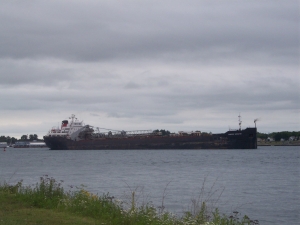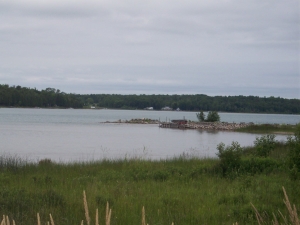 The saw mill
from the famous locks through the trucking companies which fill the roads, moving logs and other goods along the Trans-Canada Highway.
The saw mill
from the famous locks through the trucking companies which fill the roads, moving logs and other goods along the Trans-Canada Highway.
The Canadian Soo (the term used by local businesses) is larger than its American twin, but not apparently much more prosperous. It is a working class city, and the work includes the sawmill and lots of transportation-related activities,  The saw mill
from the famous locks through the trucking companies which fill the roads, moving logs and other goods along the Trans-Canada Highway.
The saw mill
from the famous locks through the trucking companies which fill the roads, moving logs and other goods along the Trans-Canada Highway.
Crossing over the International Bridge last Saturday, the border delay was long enough to let us study the operations of the saw mill, as little railroad cars delivered stacks of logs to a conveyor belt which lifted them several stories high, then returned them without their bark to the next holding pile. The incessant noise reminded us of our Domtar tour last year farther north in Ontario, and the required ear protectors. We thought that the high-pitched singing of a saw blade was a familiar sound to more than one of our ancestors.
Our Best Western is a building of much mystery itself. We can see the Bowling lanes across the parking lot, but we  Great Lakes shipping
didn't find the underground passageway till a day after we arrived (we haven't been bowling, actually). Somewhere there is an Indoor Golf area, and the swimming pool boasts a five-story waterslide which snakes around and around and spills into the pool, water coursing through continually although we've never seen anybody tumbling out. We have a large-ish room on the second floor, near Door 3. If one enters through Doors 3, 2 or 4, entry to our corridor is chancy, and at the least involves detours. We have mastered the direct routes to ice machine and our truck. The whole thing is about fifty years
Great Lakes shipping
didn't find the underground passageway till a day after we arrived (we haven't been bowling, actually). Somewhere there is an Indoor Golf area, and the swimming pool boasts a five-story waterslide which snakes around and around and spills into the pool, water coursing through continually although we've never seen anybody tumbling out. We have a large-ish room on the second floor, near Door 3. If one enters through Doors 3, 2 or 4, entry to our corridor is chancy, and at the least involves detours. We have mastered the direct routes to ice machine and our truck. The whole thing is about fifty years  Looking back on Michigan
old and these days there are always some buses parked in back.
Looking back on Michigan
old and these days there are always some buses parked in back.
One of the interesting things to do in Sault Ste Marie is to watch the river traffic. Lake freighters, just a The biggest of the tourists attractions is the casino which sits near the foot of the International Bridge next to the Tourist Information Center. It is a tidy place, nicely decorated with a North Woods theme and the trim, geometric landscaping so beloved of Ontarians. As we've learned about most casinos, there are package deals to bus in the gamblers from outlying regions on both sides of the border.
About an hour east of Sault Ste. Marie off the Trans-Canada Highway lies St. Joseph's Island, listed as an attraction in the Sault Ste. Marie Book. It is a lovely, scenic, quiet refuge. Like every other waterside location in Ontario, it is lined with boat docks and cottages, most hidden from view by the trees which cover most of the island. Several little towns include craft and gift shops, but the primary business is boating, with each populated area including a small marina. As we watched, a three-masted sailboat moved slowly under power up the river toward the big city. It whistled three blasts as it passed. The Island is locally known for its jasper rock, called puddingstone here, and for its maple sugar production -- many farmhouses have small signs inviting visitors.
The highway also includes one surprising monument. At the entrance to St. George's Marsh, a wildlife refuge about half-way between Sault Ste Marie and St. Joseph's Island, is a huge replica of the Canadian one-dollar coin. It turns out that the designer of this coin, known universally as the "loonie", lived in the area and is thus commemorated. Lest there be any doubt why the coin is so named, we enclose a photo. (And the two-dollar coin, for reasons superbly Canadian, is called, a "toonie". But of course you knew that!) Actually the successful use of coins for anything less than $5 makes more sense than keeping $1 bills, because of inflation. But the Canadians haven't succeeded in eliminating pennies, either, although it seems that we are the only ones to bend over to pick them up!
 St. Joseph's Island
St. Joseph's Island
 Big loonie
Big loonie